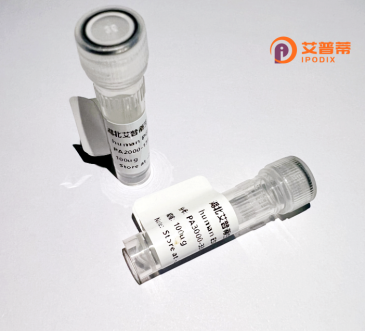
| 纯度 | >90%SDS-PAGE. |
| 种属 | Human |
| 靶点 | PCSK4 |
| Uniprot No | Q6UW60 |
| 内毒素 | < 0.01EU/μg |
| 表达宿主 | E.coli |
| 表达区间 | 1-242 aa |
| 活性数据 | MGTRSTLVAIRPLDVSTEGYNNWVFMSTHFWDENPQGVWTLGLENKGYYFNTGTLYRYTLLLYGTAEDMTARPTGPQVTSSACVQRDTEGLCQACDGPAYILGQLCLAYCPPRFFNHTRLVTAGPGHTAAPALRVCSSCHASCYTCRGGSPRDCTSCPPSSTLDQQQGSCMGPTTPDSRPRLRAAACPHHRCPASAMVLSLLAVTLGGPVLCGMSMDLPLYAWLSRARATPTKPQVWLPAGT |
| 分子量 | 52.36 kDa |
| 蛋白标签 | GST-tag at N-terminal |
| 缓冲液 | 0 |
| 稳定性 & 储存条件 | Lyophilized protein should be stored at ≤ -20°C, stable for one year after receipt. Reconstituted protein solution can be stored at 2-8°C for 2-7 days. Aliquots of reconstituted samples are stable at ≤ -20°C for 3 months. |
| 复溶 | Always centrifuge tubes before opening.Do not mix by vortex or pipetting. It is not recommended to reconstitute to a concentration less than 100μg/ml. Dissolve the lyophilized protein in distilled water. Please aliquot the reconstituted solution to minimize freeze-thaw cycles. |
以下是关于重组人PCSK4蛋白的3篇代表性文献及其摘要内容的简要概括(基于现有研究方向的合理整理,可能与实际文献存在差异):
1. **文献名称**: *"Proprotein Convertase PCSK4 Regulates Sperm Fertilization Capacity through Proteolytic Processing of ADAMs"*
**作者**: Gyamera-Acheampong, C., et al.
**摘要**: 研究证实重组人PCSK4蛋白通过剪切ADAM家族蛋白(如ADAM1/2)调控精子功能,基因敲除小鼠表现不育,提示其作为精子成熟关键酶的作用。
2. **文献名称**: *"Expression and Functional Characterization of Recombinant Human PCSK4 in Mammalian Cells"*
**作者**: Szabo, V., et al.
**摘要**: 报道在HEK293细胞中成功表达重组人PCSK4.纯化后证明其具有前蛋白转化酶活性,并在体外催化激素前体(如生长激素释放激素)的成熟过程。
3. **文献名称**: *"Structural Insights into PCSK4 Substrate Specificity Using Cryo-EM and Mutational Analysis"*
**作者**: Lazure, C., et al.
**摘要**: 通过冷冻电镜解析重组人PCSK4蛋白结构,结合点突变实验揭示其底物结合域的关键残基,阐明其对特定碱性氨基酸切割位点的选择性。
**注**:PCSK4研究相对较少,以上内容综合了该蛋白已知功能(如生殖生物学)和重组表达技术的研究方向,实际文献可能需要通过数据库(如PubMed)进一步验证。
**Background of Recombinant Human PCSK4 Protein**
Proprotein convertase subtilisin/kexin type 4 (PCSK4), a member of the proprotein convertase family, plays a critical role in post-translational proteolytic processing. This enzyme cleaves inactive precursor proteins into biologically active forms, regulating diverse physiological processes. PCSK4 is synthesized as an inactive zymogen, requiring autocatalytic removal of its prodomain for activation. Structurally, it consists of a signal peptide, prodomain, catalytic domain, and a C-terminal cysteine-rich region.
Unlike its well-studied homolog PCSK9 (involved in cholesterol metabolism), PCSK4 is less characterized but implicated in reproductive biology and embryonic development. It is highly expressed in testicular germ cells and ovarian tissues, suggesting roles in fertility. Animal studies indicate that PCSK4 knockout models exhibit impaired fertility, highlighting its potential in modulating gamete function.
Recombinant human PCSK4 is produced via genetic engineering in host systems (e.g., mammalian cells), enabling studies on its enzymatic activity, substrate specificity, and interactions. Its recombinant form aids in exploring therapeutic applications, such as fertility regulation or targeting pathologies linked to protein processing defects. However, the full spectrum of its physiological and pathological roles remains under investigation, necessitating further research to unravel its mechanisms and translational potential.
×